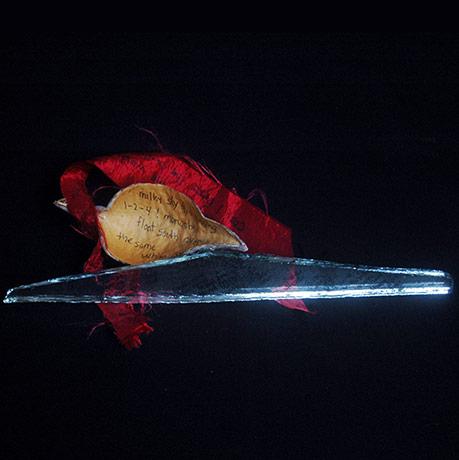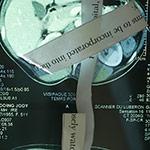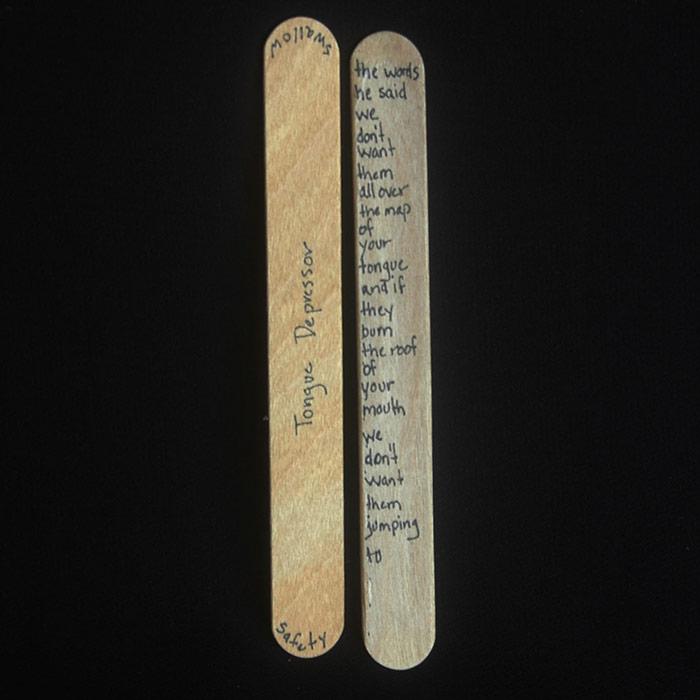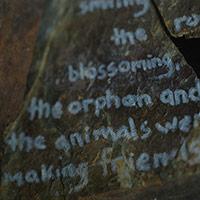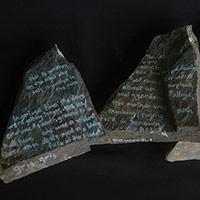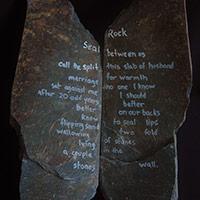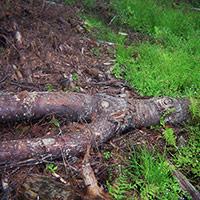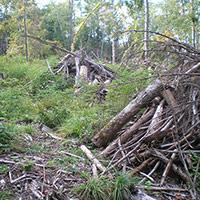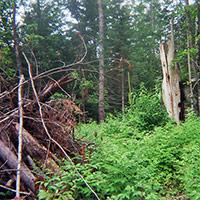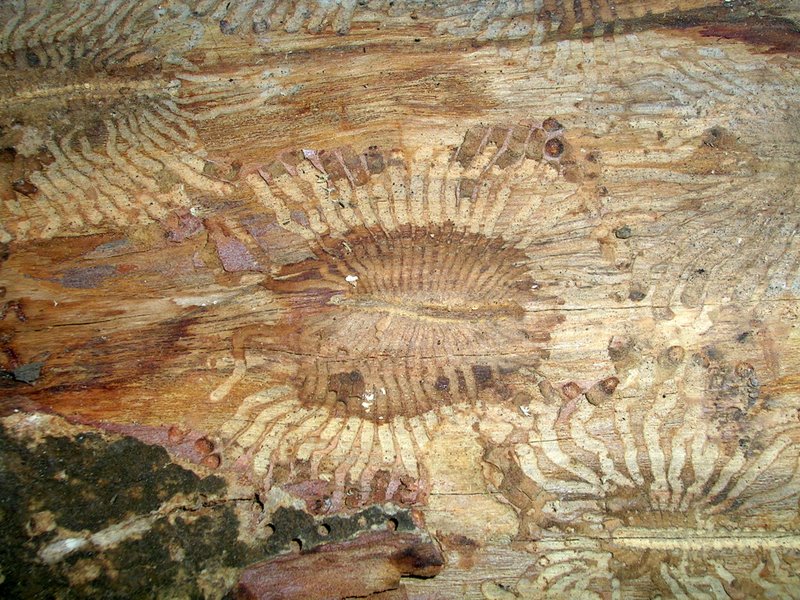Three Dimensions
Jody Gladding on translation, the sources of language, and how beetles can speak of longing.
BY Jen Bervin

Jody Gladding’s latest collection takes her abiding interest in an ephemeral art practice—encompassing ecology, poetry, and translation—and uses it as the jumping-off point to create one of the oddest, most deeply arresting and listening books that I’ve encountered.
Translations from Bark Beetle (Milkweed Editions) is made up of two basic types of poems. In the first, Gladding translates notations left by bark beetle (those squiggly inscribed lines one sometimes sees in wood) into poetry; and in the second, she inscribes her own poems on natural materials such as quarried slate or found objects—a pair of tongue depressors, for example, or a scan from a doctor’s office. The collection is an ambitious work that presses the reader to see and read language (and resituate it in the world) anew.
Click images for larger versions.
Gladding and I often teach collaboratively in the MFA Writing program at Vermont College of Fine Arts, and I was eager to hear her thoughts on Translations from Bark Beetle. What follows is an edited version of that conversation.
What draws you to specific sites? And, for that matter, to translation?
I’m interested in how a poem operates in three dimensions, in physical acts, in the world at large. The specific sites I’m drawn to—an abandoned slate quarry; a storm-damaged woodlot; the Great Salt Lake; a drystone shelter, or a borie, in France—have all offered opportunities for inquiry into the elemental sources of language, which is at the heart of my work. I suppose that’s what draws me to translation as well.
Click images for larger versions.
How and where did you first encounter a bark beetle poem?
I was working in an abandoned slate quarry [in Montpelier, Vermont], and the land around it had recently been clear-cut, so there were lots of downed white pines. I started bringing home bark, and then I started noticing the bark beetle engravings.
Click images for larger versions.
They seem charming as engravers, but it’s my understanding that bark beetles can be violently destructive too.
Yes. In western North America, bark beetle infestations are killing off the lodgepole pines. They spread Dutch elm disease by transmitting the fungus from dead to living trees. They’re an important part of the decay process, but they can do serious damage to forests. Does that make their engravings less beautiful? Maybe. It seems to me the relationship between beauty and destruction is fairly complicated. As a friend of mine said of the elm bark beetles, “Thank goodness their gallery art leaves us something to marvel at, since there are so few elms left.”
The title of the book suggests a singular author: Bark Beetle. Are all of these poems from one beetle?
The title refers to the language of bark beetle. The poems come from different bark beetle families. Most of them I found close to my home [in Vermont]. One poem was sent to me from Texas, and one I found on Orcas Island, off the Pacific coast. Whoever made these particular poems flew off long before I translated them, though I did discover a few unhatched pupae in some of the lines. I would love greater access to fluent bark beetle collaborators.
Can you walk me through your process, from finding the poem, to making the rubbing, to identifying forms...?
May I walk you through the bark beetle’s process instead?
In summer, an adult beetle flies in search of the particular kind of tree that serves as its host. It chews a hole through the bark and creates a small chamber in the wood for mating. After mating, the male leaves and the female chews a main tunnel, depositing eggs at notches all along it. The eggs hatch into larvae that chew their way from the notches, making tunnels that get wider as they grow. They overwinter at the end of these tunnels. In spring they form pupae, then hatch into adult beetles that bore holes straight through the bark and fly off to repeat the cycle.
Bark beetle galleries with bark showing exit holes, photo by L. Shyamal
Forgive my indiscretion, but if the beetles are eating, that food must be going somewhere. Is that part of the language too?
It may be, but it hasn’t shown up in the work I've translated. Bark beetles make their presence known both by their poems and by the boring dust that results from their chewing. Careful editors that they are, the boring dust seems to get excised from the poems.
And is a bark beetle poem ever finished or only abandoned?
Abandoned!
How did the beetle’s process inform your own? How did you approach translating bark beetle?
My approach combines what I understand about the way bark beetles make poems, with what I understand about making poems myself, with what I understand about translating. I study the lines; do rubbings to see what the forms, flattened, might tell me; compare one poem to another; read up on bark beetle. Then I set to work. Any methods I’ve developed are crude, to say the least, yet each poem teaches me something new, and I love that.
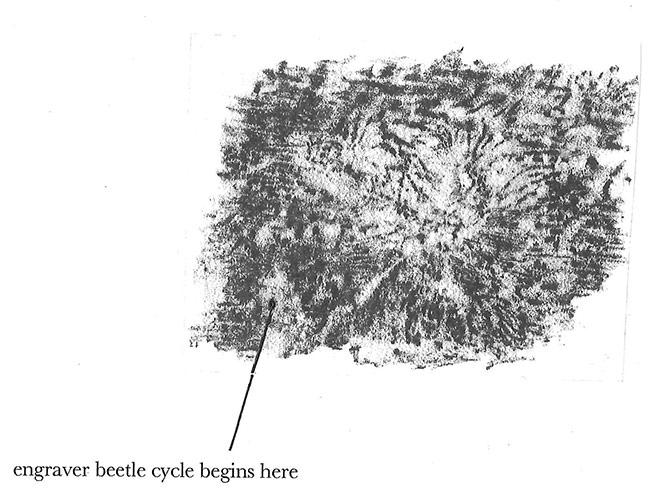
Image courtesy of Jody Gladding and Milkweed Editions.
How do bark beetle poems relate to the lives of the beetles?
My feeling is that they are love poems. Like many of our poems, they speak of longing. It takes many bark beetles, developing through many stages of their lives, to complete a bark beetle poem. Often they are working parallel to one another, making lines that never cross, though they can sense one another’s vibrations through the wood.
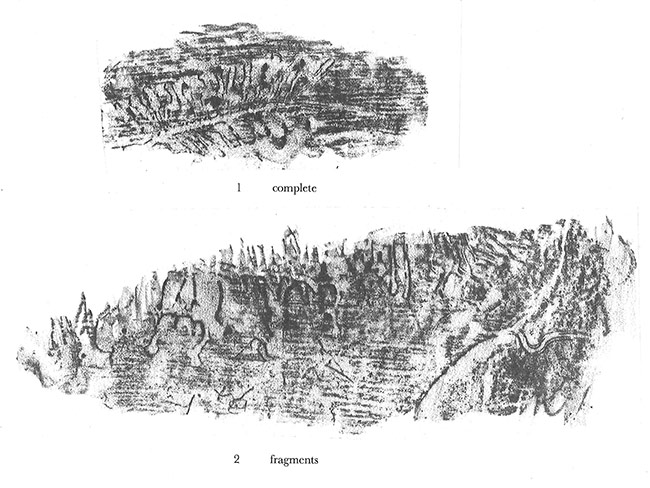
Image courtesy of Jody Gladding and Milkweed Editions.
What is their relationship to writing materials?
I would say that, rather than [writing] materials, bark beetles have a medium, which is wood. They mate and reproduce in it, they feed on it, they communicate through it.
The artist Paul Klee talked about “taking a line for a walk”—what do bark beetles do with theirs?
Well, they basically eat them. A bark beetle’s line is the path its body makes on the way to discovering what comes next.
What is untranslatable from bark beetle?
You see, that’s the mystery—how can we even know what’s untranslatable if we can’t translate it? But in undertaking these bark beetle translations, I can begin to discover what’s untranslatable. I can begin to imagine myself as a tiny cylindrical creature chewing my way through wood, elaborating patterns some other species may find compelling enough to want to read. I can begin to imagine that species, and the violences and elegances of its language: I can begin to understand what is untranslatable about my own kind.
Poet and visual artist Jen Bervin's interdisciplinary practice encompasses poetry, archival research, artist books, and large-scale art works. With Marta Werner she coedited The Gorgeous Nothings: Emily Dickinson's Envelope Poems (2012), which was a finalist for the Poetry Foundation’s 2014 Pegasus Award for Criticism and made Best Books of 2013 lists in the New Yorker and the Times Literary Supplement...



